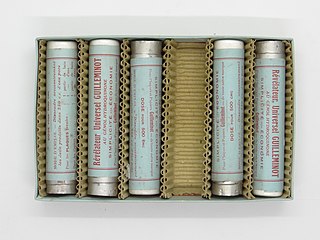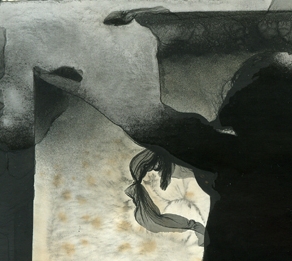Related Research Articles

Film stock is an analog medium that is used for recording motion pictures or animation. It is recorded on by a movie camera, developed, edited, and projected onto a screen using a movie projector. It is a strip or sheet of transparent plastic film base coated on one side with a gelatin emulsion containing microscopically small light-sensitive silver halide crystals. The sizes and other characteristics of the crystals determine the sensitivity, contrast and resolution of the film. The emulsion will gradually darken if left exposed to light, but the process is too slow and incomplete to be of any practical use. Instead, a very short exposure to the image formed by a camera lens is used to produce only a very slight chemical change, proportional to the amount of light absorbed by each crystal. This creates an invisible latent image in the emulsion, which can be chemically developed into a visible photograph. In addition to visible light, all films are sensitive to X-rays and high-energy particles. Most are at least slightly sensitive to invisible ultraviolet (UV) light. Some special-purpose films are sensitive into the infrared (IR) region of the spectrum.
Photographic processing or photographic development is the chemical means by which photographic film or paper is treated after photographic exposure to produce a negative or positive image. Photographic processing transforms the latent image into a visible image, makes this permanent and renders it insensitive to light.

Photographic paper is a paper coated with a light-sensitive chemical formula, like photographic film, used for making photographic prints. When photographic paper is exposed to light, it captures a latent image that is then developed to form a visible image; with most papers the image density from exposure can be sufficient to not require further development, aside from fixing and clearing, though latent exposure is also usually present. The light-sensitive layer of the paper is called the emulsion. The most common chemistry was based on Silver halide but other alternatives have also been used.

In photography, reversal film or slide film is a type of photographic film that produces a positive image on a transparent base. Instead of negatives and prints, reversal film is processed to produce transparencies or diapositives. Reversal film is produced in various sizes, from 35 mm to roll film to 8×10 inch sheet film.

In the processing of photographic films, plates or papers, the photographic developer is one or more chemicals that convert the latent image to a visible image. Developing agents achieve this conversion by reducing the silver halides, which are pale-colored, into silver metal, which is black. The conversion occurs within the gelatine matrix. The special feature of photography is that the developer acts more quickly on those particles of silver halides that have been exposed to light. Paper left in developer will eventually reduce all the silver halides and turn black. Generally, the longer a developer is allowed to work, the darker the image.
Photographic printing is the process of producing a final image on paper for viewing, using chemically sensitized paper. The paper is exposed to a photographic negative, a positive transparency , or a digital image file projected using an enlarger or digital exposure unit such as a LightJet printer. Alternatively, the negative or transparency may be placed atop the paper and directly exposed, creating a contact print. Digital photographs are commonly printed on plain paper, for example by a color printer, but this is not considered "photographic printing".
C-41 is a chromogenic color print film developing process introduced by Kodak in 1972, superseding the C-22 process. C-41, also known as CN-16 by Fuji, CNK-4 by Konica, and AP-70 by AGFA, is the most popular film process in use, with most photofinishing labs devoting at least one machine to this development process.

In photography, toning is a method of changing the color of black-and-white photographs. In analog photography, it is a chemical process carried out on metal salt based prints such as Silver Prints, Iron Based Prints, Platinum or Palladium Prints photographic prints. This darkroom process cannot be performed with a color photograph. The effects of this process can be emulated with software in digital photography. Sepia is considered a form of Black and White or Monochromatic Photography.

The ADOX brand for photographic purposes has been used by three different companies since its original conception over one hundred fifty years ago. ADOX was originally a brand name used by the German company, Fotowerke Dr. C. Schleussner GmbH of Frankfurt am Main, the world's first photographic materials manufacturer. In 1962 the Schleussner family sold its photographic holdings to DuPont, an American company. DuPont used the brand for its subsidiary, Sterling Diagnostic Imaging for X-ray films. In 1999, Sterling was bought by the German company Agfa. Agfa did not use the brand and allowed its registration to lapse in 2003. Fotoimpex of Berlin, Germany, a company founded in 1992 to import photographic films and papers from former eastern Europe immediately registered the brand and today ADOX is a brand of black and white films, photographic papers and photochemistry produced by ADOX Fotowerke GmbH based in Bad Sarrow near Berlin.

Ilford Photo is a UK manufacturer of photographic materials known worldwide for its black-and-white film and papers and chemicals, and its range of Ilfochrome and Ilfocolor colour printing materials, before these were discontinued. Ilfochrome was formerly called Cibachrome, developed in partnership with the Swiss company CIBA-Geigy. Formerly, it published the Ilford Manual of Photography, a comprehensive manual of everything photographic, including the optics, physics and chemistry of photography, along with recipes for many developers.
Chromogenic photography is photography that works by a chromogen forming a conventional silver image and then replacing it with a dye image. Most films and papers used for color photography today are chromogenic, using three layers, each providing their own subtractive color. Some chromogenic films provide black-and-white negatives, and are processed in standard color developers. In this case, the dyes are a neutral color.
A chromogenic print, also known as a C-print or C-type print, a silver halide print, or a dye coupler print, is a photographic print made from a color negative, transparency or digital image, and developed using a chromogenic process. They are composed of three layers of gelatin, each containing an emulsion of silver halide, which is used as a light-sensitive material, and a different dye coupler of subtractive color which together, when developed, form a full-color image.

Color motion picture film refers both to unexposed color photographic film in a format suitable for use in a motion picture camera, and to finished motion picture film, ready for use in a projector, which bears images in color.
Dye destruction or dye bleach is a photographic printing process, in which dyes embedded in the paper are bleached (destroyed) in processing. Because the dyes are fully formed in the paper prior to processing, they may be formulated with few constraints, compared to the complex dye couplers that must react in chromogenic processing. This method has allowed the use of richly colored, highly stable dyes. It is a reversal process, meaning that it is used in printing transparencies (diapositives).
The following outline is provided as an overview of and topical guide to photography:

Photographic film is a strip or sheet of transparent film base coated on one side with a gelatin emulsion containing microscopically small light-sensitive silver halide crystals. The sizes and other characteristics of the crystals determine the sensitivity, contrast, and resolution of the film.

Mordançage is an alternative photographic process that alters silver gelatin prints to give them a degraded effect. The mordançage solution works in two ways: it chemically bleaches the print so that it can be redeveloped, and it lifts the black areas of the emulsion away from the paper giving the appearance of veils. Once the emulsion is lifted, it can then be removed or manipulated depending on the desired outcome. Areas where the emulsion was removed appear to be in relief. These prints can become oxidized during their creation, further altering the tonality of the image.
The conservation and restoration of film is the physical care and treatment of film-based materials. These include photographic film and motion picture film stock.
References
- ↑ Wilhelm, Henry (2006). "A 15-Year History of Digital Printing Technology and Print Permanence in the Evolution of Digital Fine Art Photography - From 1991 to 2006" (PDF). Society for Imaging Science and Technology. Retrieved 17 April 2018.
- ↑ Araujo, Anderson. "Ilford chronology". Ciba 1963. Retrieved 2011-11-13.
- ↑ Araujo, Anderson. "Ilford chronology". Ciba 1989. Retrieved 2011-11-13.
- ↑ Araujo, Anderson. "Ilford chronology". Ciba 1992. Retrieved 2011-11-13.
- ↑ Annaratone, Marco. "Going Ultra: Ultra Large Format and In-Camera Ilfochrome" (PDF). Going Ultra. Archived from the original (PDF) on 2016-03-03. Retrieved 2008-02-25.
- ↑ Evans, Glenn. "Shooting Cibachrome in-camera". Glennview. Retrieved 2008-02-25.